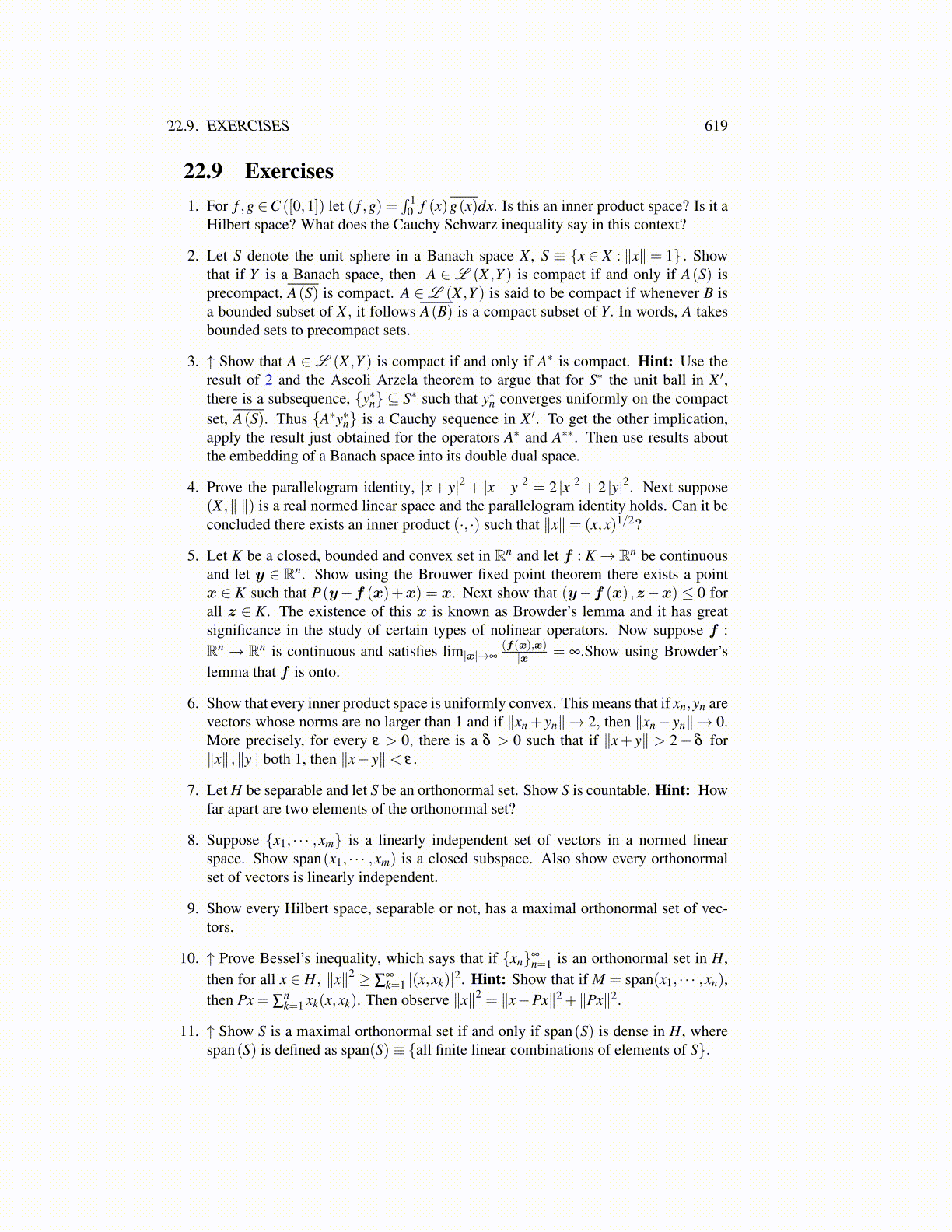
22.9. EXERCISES 619
22.9 Exercises1. For f ,g ∈C ([0,1]) let ( f ,g) =
∫ 10 f (x)g(x)dx. Is this an inner product space? Is it a
Hilbert space? What does the Cauchy Schwarz inequality say in this context?
2. Let S denote the unit sphere in a Banach space X , S ≡ {x ∈ X : ∥x∥= 1} . Showthat if Y is a Banach space, then A ∈ L (X ,Y ) is compact if and only if A(S) isprecompact, A(S) is compact. A ∈L (X ,Y ) is said to be compact if whenever B isa bounded subset of X , it follows A(B) is a compact subset of Y. In words, A takesbounded sets to precompact sets.
3. ↑ Show that A ∈L (X ,Y ) is compact if and only if A∗ is compact. Hint: Use theresult of 2 and the Ascoli Arzela theorem to argue that for S∗ the unit ball in X ′,there is a subsequence, {y∗n} ⊆ S∗ such that y∗n converges uniformly on the compactset, A(S). Thus {A∗y∗n} is a Cauchy sequence in X ′. To get the other implication,apply the result just obtained for the operators A∗ and A∗∗. Then use results aboutthe embedding of a Banach space into its double dual space.
4. Prove the parallelogram identity, |x+ y|2 + |x− y|2 = 2 |x|2 + 2 |y|2. Next suppose(X ,∥ ∥) is a real normed linear space and the parallelogram identity holds. Can it beconcluded there exists an inner product (·, ·) such that ∥x∥= (x,x)1/2?
5. Let K be a closed, bounded and convex set in Rn and let f : K→ Rn be continuousand let y ∈ Rn. Show using the Brouwer fixed point theorem there exists a pointx ∈ K such that P(y−f (x)+x) = x. Next show that (y−f (x) ,z−x) ≤ 0 forall z ∈ K. The existence of this x is known as Browder’s lemma and it has greatsignificance in the study of certain types of nolinear operators. Now suppose f :Rn → Rn is continuous and satisfies lim|x|→∞
(f(x),x)|x| = ∞.Show using Browder’s
lemma that f is onto.
6. Show that every inner product space is uniformly convex. This means that if xn,yn arevectors whose norms are no larger than 1 and if ∥xn + yn∥ → 2, then ∥xn− yn∥ → 0.More precisely, for every ε > 0, there is a δ > 0 such that if ∥x+ y∥ > 2− δ for∥x∥ ,∥y∥ both 1, then ∥x− y∥< ε .
7. Let H be separable and let S be an orthonormal set. Show S is countable. Hint: Howfar apart are two elements of the orthonormal set?
8. Suppose {x1, · · · ,xm} is a linearly independent set of vectors in a normed linearspace. Show span(x1, · · · ,xm) is a closed subspace. Also show every orthonormalset of vectors is linearly independent.
9. Show every Hilbert space, separable or not, has a maximal orthonormal set of vec-tors.
10. ↑ Prove Bessel’s inequality, which says that if {xn}∞n=1 is an orthonormal set in H,
then for all x ∈ H, ∥x∥2 ≥ ∑∞k=1 |(x,xk)|2. Hint: Show that if M = span(x1, · · · ,xn),
then Px = ∑nk=1 xk(x,xk). Then observe ∥x∥2 = ∥x−Px∥2 +∥Px∥2.
11. ↑ Show S is a maximal orthonormal set if and only if span(S) is dense in H, wherespan(S) is defined as span(S)≡ {all finite linear combinations of elements of S}.